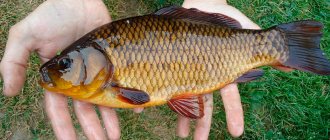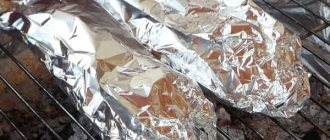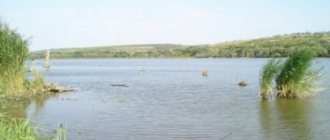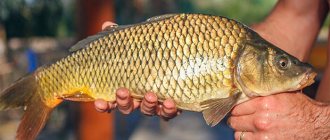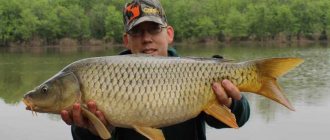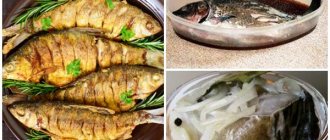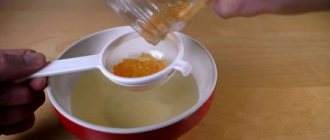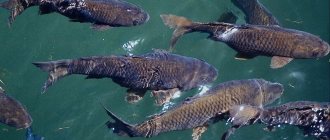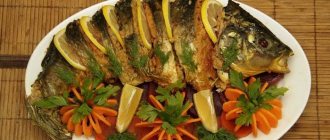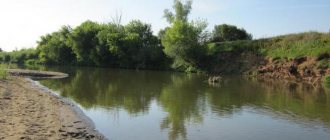Carp
, in terms of its size and significance for fishermen and fisher-hunters, undoubtedly ranks first among all the fish of its family, which received its name from it. But in terms of fishing, despite the fact that in Southern Russia and especially in the lower reaches of large rivers of the Black, Caspian and Aral Seas, carp is caught in huge quantities, it does not have the same importance as, for example, bream, syrt, ram and roach, and it is still almost never stored anywhere for future use.
Description
Carp Carp is a cultivated form of carp.
There are several forms of carp: naked, mirror and scaly. Fishermen usually come across wild carp, which somehow got into the reservoir from fish farms. Spawning coincides with the end of flowering of gardens and the opening of the swimming season and occurs in shallow grassy areas. Carp feeds on various aquatic organisms and larvae, as well as all kinds of plant foods. Begins to feed from the time of cherry blossoms. However, in a number of reservoirs, its fishing begins only after spawning. There are reservoirs rich in food, where he generally does not pay attention to the most seemingly tasty baits. In spring and early summer, carp prefer a worm or half a crawler. After spawning, it bites better on cereal grains, potatoes and dough. Real river carp, or carp, is very beautiful. It is covered with unusually large dark yellow-golden scales, which are darker on the back, with a bluish tint, and lighter on the belly; It seems as if the golden field is strewn with carnations with dark caps. At first glance, carp, especially young ones, have a fairly strong resemblance to crucian carp, but it is not so high in the back (the height of the body is only twice as thick), thicker and longer, and immediately differs from the latter with its 4 thick and short antennae on yellow, unusually fleshy lips, almost as mobile as those of bream; These antennae sit in pairs on each side and end in roundish, flat heads. The dorsal fin is very wide, wider than that of other cyprinids, and occupies almost the entire back half of the back, dark gray in color. In addition to its width, it is distinguished by a very strong sawtooth, jagged front ray. The dorsal fin of the barbel myron has such a ray, but in carp the anterior ray of the anal fin has the same structure. All lower fins are grayish-violet, the caudal fins are red-brown; golden eyes. The pharyngeal teeth, lying in the pharynx, found in all carp fish and used for grinding solid food, are distinguished by their massiveness; There are five of them on each side, arranged in two rows. Young carp, 2-3 years of age, are much flatter, wider, humpbacked and lighter than adults, which is why they are sometimes called lapys and croakers. Large carps have an almost cylindrical body.
But both in color and body composition, carp, this widely distributed and even, one might say, domesticated fish, is subject to numerous and strong modifications. On the one hand, there are varieties with a very elongated, almost cylindrical body, on the other hand, there are carp whose body shape is similar to silver crucian carp. The latter seem to be increasingly found in ponds and generally in small enclosed pools, while oblong carp are more often found in estuaries, in the sea or in large lakes.
Spreading
Thanks to breeding, carp is widespread in many reservoirs in Russia and abroad.
The distribution of carp in Asia Minor and Persia has not yet been studied, but it is found in huge numbers in the Aral Sea, in the Syr Darya and Amu Darya; There are no carp in Siberian rivers.
Carp distribution
Carp lives in ponds, lakes, oxbow lakes, quarries, stakes, and reservoirs. Carp prefers water bodies overgrown with aquatic vegetation with a slightly silted or hard, but not rocky bottom. Mainly stays at depth.
Distribution and favorite places
Carp is an unpretentious fish that thrives in polluted waters. But his love for warmth does not allow him to get along in the northern regions. Therefore, it is possible to catch carp only in the southern and central zones of Russia, in Hungary, France, Germany, the Czech Republic, Australia and the USA. Since the fish is freshwater, it can only be found in rivers and lakes. Cases of life in salted waters have been observed. However, this was a forced situation: a dam was broken, which blocked access to the sea.
Carp prefers to live in standing and quiet or moderately flowing waters. He loves a hard clay bottom, but covered with a small layer of silt. During the freeze-up period, the fish lie on the bottom in holes. In summer it prefers to stay near underwater thickets, reeds and snags.
Age and size
Carp grows very quickly. By the end of the first year of life, its length is already about 10 cm with a weight of 25-30 g. In favorable conditions, by the end of the second year it weighs 450-500 g, and in the third year (puberty sets in) its weight reaches 2 kg. The size of an adult carp can be 100-120 cm in length and weigh 20-25 kg or more. The usual length is 50-70 cm with a weight of 4-6 kg. Lives up to 30 years. historical facts are known about caught carp weighing up to 70 kg and measuring up to 1.5 meters. River and sea carps of South-Eastern Europe, including Caspian carp, reached this weight and size. There is also reliable information about pond carp that have reached not only a century, but even two hundred years of age.
Typically, the length of an adult carp is from 30-50 cm to 1 m and the weight is up to 15-25 kg, rarely the length is up to 1.5 m and the weight is up to 35 kg. The body of the carp is thick, moderately elongated, laterally compressed, covered with large scales. The head is large, the mouth is lower, the lips are well developed. The upper lip has two pairs of well-developed short whiskers. The dorsal fin is long with a small notch, the anal fin is short, and the caudal fin is deeply notched. The dorsal and anal fins each have a serrated spiny ray (saw). The sides are golden light, the back is darkish, the fins, except the dorsal, are reddish. Color may vary depending on habitat.
World record
The largest carp in the world was caught back in 1937. For six months, a river monster in Lake Ostend (Belgium) terrified local residents and curious tourists. After much effort, he was caught. As it turned out, it was a carp 3.5 meters long and weighing 190 kg!
The record was not officially recorded, so the category “Largest carp caught” includes an individual weighing 120 kg and almost two meters long. It was caught by Thai fishermen in 2007 in the vicinity of Bangkok, on Lake Byngsamran. This record has not yet been officially broken.
Lifestyle
Carp prefer quiet and deep places overgrown with pondweed, water lilies, reeds and cattails.
In rivers it prefers areas with calm currents, lives on reaches, bays and oxbow lakes with well-developed aquatic vegetation. Leads a gregarious lifestyle and does not migrate far. In autumn, as the water temperature drops, it moves to deeper places, where it spends the winter in a sedentary state. Prefers silt or clay soil. At night, in search of food, carp enter small creeks and backwaters overgrown with grasses. Carp can be found along steep banks, near the riverbed, and if the river is not wide, then in the riverbed itself, on a weak current near a clayey or silty-clayey bottom. In lakes, the favorite habitats of carp are underwater hills, saddles between the depths, the boundaries of shallows, capes above bays and backwaters, deep channels with reverse flow, uneven areas of the bottom with large stones - all these are ways for carp to exit and return to the site. Carp is a heat-loving, schooling and sociable fish. In the same flock there are carps of different ages, sizes and weights - from 1-1.5 kg to 8 kg or more. But the largest carp live separately from the smaller ones. At dawn, the carp noisily throws itself up out of the water and with a splash falls back flat. In lakes and reservoirs, it sticks to the deepest places, not far from shores overgrown with algae; it is especially attracted to islands with a wide strip of algae, where the fish go to feed. In rivers, carp stick to quiet, deep holes in slow currents, especially if the banks of the holes are steep and washed away. They often occupy deep bays and oxbow lakes.
Sexual maturity of carp occurs at the age of 3 years. A female carp lays an average of 200 thousand eggs or more. Spawning occurs when the water temperature is not lower than 18 degrees, usually in the second half of May, early June. For spawning, shallow water with a large amount of aquatic vegetation and a depth of 40-50 cm is chosen. The carp spawns for several days, first small individuals, then medium-sized ones, and at the very end large ones. The caviar is yellowish in color. The eggs are sticky and stick to vegetation. Spawning is gregarious and noisy.
Carp behavior after spawning
After the end of spawning, the carp gradually leaves the spawning grounds and takes up its usual habitats. At this time, he begins to actively feed, restoring strength after spawning. Usually the bite begins in May. At this time, it is caught using a float rod using grains of corn, peas, bread pellets, a worm and many other baits.
In deep areas it is better to use bottom fishing rods. Feeder gear will also perform well when fishing for scaly lumps
When summer comes into its own and the water warms up to the maximum, the intensity of the bite decreases. If water blooms are observed in a reservoir, then it may stop feeding altogether. On hot, sunny days, carp often stand at the very surface of the water. At this time, it is easy to detect with the help of polarized glasses. Polarized glasses differ from regular sunglasses in that they eliminate glare coming from the surface of the water. Thanks to this, the angler gets the opportunity to look several tens of centimeters deep into the water.
Recommended reading: Asp fish
If you find a carp standing at the surface of the water, you can try to catch it using a rig with a water ball. The water ball allows you to apply the nozzle on the surface itself. When fishing like this, it is best to use a regular crust of bread as bait. It is quite natural that if you add an attractant, the number of bites will increase. This fish loves fruity and sweet aromas.
With a gradual decrease in water temperature, carp become more active. In autumn there is generally a peak bite. At least until the water temperature dropped below 10 degrees. After reaching this mark, the pace of life of the fish begins to slowly decrease. This phenomenon is easy to explain. When the weather cools in autumn, fish sense the approach of winter. Of course, he is trying to prepare for winter as best as possible. This explains the strong surge in biting.
Carp fishing
Carp are caught with a float rod. The rod must be powerful, even if it is equipped with a reel. The line is usually 0.5 mm with a leader of 0.4 mm. It is clear that the thickness of the fishing line depends on the size of the carp found in the reservoir. For catching carp weighing 1.5–2 kg, a leash thickness of 0.3 mm is sufficient, but for giants weighing 10 kg, a fishing line 0.7 mm thick may be weak, especially for blind tackle. When catching large carp, you need a thick leash (vein leash is unsuitable due to its rigidity) made of silk or nylon, preferably wicker. Camouflage of gear for carp fishing is absolutely necessary, just like camouflage of the fisherman. Sometimes long-distance casting of bait with a sliding float or using a spinning reel helps. Coastal thickets or wicker camouflage shields, which can also be installed on a boat, camouflage the fisherman well.
Reel tackle is very helpful both in long-distance casting and when retrieving, and allows you to use much thinner, invisible line. The sizes of hooks are selected according to the bait, but double-strength hooks are required. By the way, carp have a rather big mouth. You can use hooks ranging from No. 6 to 12, depending on the size of the fish. Carp fishing almost always occurs in algae thickets and from the bottom, so the line and leash are painted gray-green to resemble algae. For successful fishing, it is very important to choose the right fishing location.
At dawn, the carp noisily throws itself up out of the water and with a splash falls back flat. In lakes and reservoirs, it sticks to the deepest places, not far from shores overgrown with algae; it is especially attracted to islands with a wide strip of algae, where the fish go to feed. In rivers, carp stick to quiet, deep holes in slow currents, especially if the banks of the holes are steep and washed away. They often occupy deep bays and oxbow lakes. They are caught not in the pit itself where they live, but on the paths along which carp move to feed. If it was possible to determine their parking place based on the skids, then you need to try to determine which way they will go to the algae thickets to feed. You need a flat area, clear of snags and rubbish, at least 5–6 m long and at least 4–5 m wide, with a depth of no more than 3 m, at a distance of up to 20 m from the parking lot.
On the shore, near the fishing site, sizha is prepared, which is camouflaged if possible. To regularly fish such places, you need to select three or four. Carp feed along and near the shore, not missing the shallows near the riverbed along the way. The bait must lie on the bottom, and the sinker must barely touch it or be 1–2 cm from the bottom. It is very important. It will be easier to notice the fish touching the bait and prepare for hooking in a timely manner. The carp bite is sometimes so fast that the rod ends up jerking into the water. But more often, in the hot season of summer, he carefully takes bait, especially vegetable baits, slightly moving the float, slightly lifting it. Then, if the fish liked the bait, the float, slowly sinking, will go under water. This cutting moment should not be missed. When fishing with grain baits, you need to hook when the float is rising, but if you hook too early, the carp can easily break loose and lead the whole flock away from you. Determining and describing the moment of timely hooking for each bait is difficult, sometimes impossible. This comes with practice.
Masking should be maximum. The fisherman's suit, especially above the waist, should blend into the background of the shore. Walking along the shore is completely unacceptable. The ends of the rods should not protrude beyond the shore line more than 1 m. Even on permanent and already proven feeding routes, carp must be fed. This keeps the flock in the right place, sometimes for the entire dawn, since the flock, slightly frightened by the landing of one, returns to feeding again. Complementary food, like bait, should contain steamed cake. Cereals and potatoes must be cooked with cake.
Fishing for carp After spawning, in mid-summer, carp feed from dusk until dawn, sometimes until 8–9 o’clock. In shaded areas, the bite occurs until almost noon. At the beginning and end of summer, on cool days, carp take better in the morning after heating, when the dew begins to dry. You should not check and re-throw the tackle often and unnecessarily - this scares away the fish. The carp hook should be sharp, but short, especially if the cast was not long. You just need to pierce the fleshy mouth of the fish. Fighting carp requires resourcefulness and endurance. The main condition for success is to counter all the jerks of the fish with a well-tensioned line and pull the fish onto the landing net at the slightest opportunity. When the line weakens, the carp can wrap it around itself and tear it with the sharp teeth of the first ray of the dorsal fin.
In recent years, in reservoirs such as lakes and reservoirs, bottom fishing rods have begun to be successfully used for carp fishing. This fishing has a number of features: long casts are not needed, 8–12 m is enough, it is better if the angler is located 5–7 m behind the coastline, which camouflages him. A carp fishing rod should be at least 1.2 m long; spinning one-handed rods are good. The rod is supported by a powerful fork to counteract the sudden jerk of the fish; signaling devices should be light in weight and as sensitive as possible. Semaphore type signaling devices are especially good. Carp acutely senses weather changes, sometimes stops feeding 2 days before the onset of such a change. The bite also weakens in variable, unstable weather. However, the carp's jumps always show that it is getting ready to feed, but sometimes it bites even without playing. At a feeding site, carp can be identified by bubbles rising from the bottom to the surface as they rummage through the mud, looking for food.
Catching carp requires a lot of patience and composure. Those who are not sufficiently endowed with them are better off catching other fish. But catching large fish often brings unforgettable moments to a skillful and patient fisherman. To catch especially large carp, the fishing rod is specially equipped with: a leash made of nylon or silk cord with a diameter of 0.8 and a length of 8 cm; steel leash with a diameter of 0.3 mm, a length of 30 cm from three elbows; a core of line with a diameter of 0.7 mm and, finally, a reel capable of holding at least 60 m of this line. A steel leash after a soft one is necessary so that the carp does not break the line with the teeth of its fin. Only an end sinker is placed on the bottom fishing rod; sliding ones are unsuitable - they do not transmit the bite well when immersed in silt.
In autumn, with the coloring of the leaves and the beginning of the mass digging of potatoes, carp feed in the afternoon and evening. In cloudy but warm weather - all day, but better in the morning and evening. With the beginning of cold mornings, the carp goes to the most remote and deep holes and stops feeding. The exception is stray carp, which have just been lost from fish farms during the release and fishing of ponds. Once in a new body of water, stray carp look for a place to winter and continue to feed almost until freeze-up, which depends on the availability of nearby places suitable for wintering. In winter, from under the ice, in deep holes and near reservoir dams, large carp are occasionally caught using a brass spoon while trolling perch. In general, they lie down for the winter and become numb when ice appears.
Carp. Types of carp. Record carp
There is an old saying. “In order to defeat your opponent, you need to study him.” This article will be about carp and its species.
Carp (lat. Cyprinus carpio carpio) is a domesticated form of carp, a fish of the carp family. The weight of carp usually reaches 12 kg with a length of 100 cm, but there are giant carp that can reach a weight of up to 50 kg with a length of more than 150 cm. Often this is only possible by crossing, for example, wild river carp with carp or some other sequential crosses. Common (scaly) carp
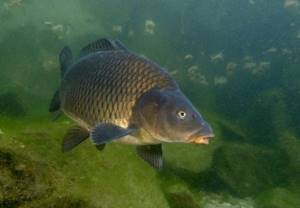
It is not possible to provide a table of the correspondence between the length and weight of carp due to the fact that there are species of carp with different body shapes that, despite the same length, can have significantly different weights. This difference is especially observed between oblong and round carp. One thing I can say for sure is that an oblong carp with a length of 1 meter weighs 12 kg. Carp (lat. Cyprinus carpio) is a freshwater fish of the carp family of the order Cypriniformes. Inhabits the basins of the Azov, Black, Caspian, Aral Seas, Lake Balkhash, Kapchagai, and the Amur River. Sazan, translated from the Kazakh language, means living in silt and this word is not of Slovenian origin, unlike the word korop. Mirror carp
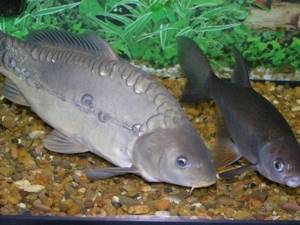
Carp is by far the most famous fish in the family from which it takes its name. The word “carp” translated from Greek means fruit. Apparently, the name carp given to the cultivated form of carp is due to the extremely high fertility of this fish, which lays from 96 thousand to 1.8 million eggs. Before the times of Kievan Rus, the Slavs called this fish korob, and later, during the existence of Kievan Rus, this word was transformed into the word korop. The carp was called a box because it was transported and settled in reservoirs (ponds) that belonged to nobles in tightly packed wooden boxes. Since it was primarily prestigious, and the tradition of keeping fish in ponds came to us from the east, from China, where wealthy people kept goldfish (golden crucian carp) and koi (colored carp). From these reservoirs it spread to wild reservoirs and lakes and rivers. To this day, in Ukrainian, carp is called korop. naked carp
Carp is a valuable commercial species. A very long time ago they began to grow it in ponds, making it a “domestic fish”. Carp farming first developed in China, and then independently in Europe. The original form of European domestic carp is the Danube carp. It is reliably known that the Romans, who highly valued this fish, brought it from the Danube. Apparently, the first experiments in pond breeding of carp in Europe belonged to the Romans. In the Mediterranean basin, carp were bred already during the Christian period and gradually spread further and further to the north. Carp grows quickly, easily tolerates low oxygen content in water, is not picky about food and therefore easily takes root in ponds. Carp
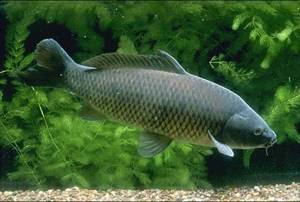
Acclimatized in many reservoirs of Central Asia, Western and Central Siberia and Kamchatka. The forms of carp are residential and semi-anadromous. The first constantly lives in one body of water, the second - in desalinated areas of the sea or lakes, migrating to spawning rivers. There are, although rare, specimens weighing over 20 kg and more than a meter long. The carp lives a long time - up to 30-35 years, but its growth stops at 7-8 years, that is, the main weight gain occurs in the first quarter of life. In spring and early summer, carp mainly feeds on young shoots of reeds, cattails, egg capsules, pondweed and other aquatic plants, and readily eats the eggs of early spawning fish and frogs. Golden carp (albino carp) In summer, the diet of carp changes somewhat - the leaves of aquatic plants, although included in the menu, recede into the background. Now the basis of nutrition consists of aquatic insects, worms, small snails, egg capsules, molting crayfish, small leeches, etc. It also readily eats invertebrate mollusks, zebra mussels, small pearl barley, cattails, and pond snails. In autumn, it completely abandons plants and switches to small aquatic insects and invertebrates. Spawns at a temperature of 18-20 °C. Puberty at 2-5 years of life. Fertility is about 1.5 million eggs. Spawning in portions, from April to July. Spawns in fresh and brackish water, in the coastal zone among vegetation. The cultural form of carp, the carp, was obtained through selection. Carp in a jump

Scientific classification Kingdom: Animals Type: Chordata Class: Ray-finned Order: Cyprinidae Family: Cyprinidae Genus: Carp Species: Carp Subspecies: Carp Carp jumping
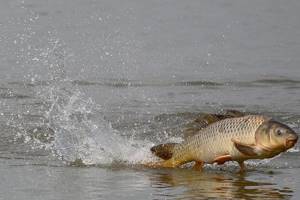
Golden carp is a large omnivorous fish of yellow-green and brown color, has a thick, moderately elongated body, covered with large, smooth, golden-brown, tightly fitting scales. The head is big. The mouth is semi-lower, retractable. The lips are well developed. The upper lip has two pairs of well-developed short whiskers. The dorsal fin is long with a small notch, the anal fin is short. The dorsal and anal fins each have a jagged, spiny ray (“file”). The sides are golden in color, the back is darkish. The color may vary depending on the habitat. Notable are the mirror or king carp (Cyprinus rex cyprinorum) with very few rows of extremely large scales and the rest of the body bare, and the leathery carp (Cyprinus nudus) with completely bare skin. Carp underwater
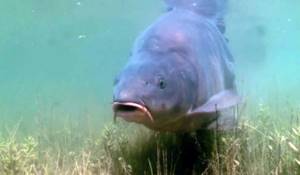
Lives in rivers, reservoirs, rates, lakes, where it inhabits quiet, stagnant or slowly flowing waters with a hard clayey, slightly silted bottom. In the lower reaches of rivers flowing into the Black Sea, carp are found in brackish waters. During the winter, carp lie down in deep holes, their body becomes covered with a thick layer of mucus, stops feeding, and breathing slows down. Carp are very sensitive to low temperatures and therefore carp spawning usually occurs when the water is well warmed up. Carp go into winter in the fall and come out into the water when it completely melts. Carp, unlike tench and crucian carp, which bury themselves in silt for the winter, like catfish, overwinters in pits and comes out into the water only at the end of April, and then reluctantly walks near its shelter, but with the arrival of water and an increase in temperature, it rises closer to the surface. And when the water spills and floods the meadows, the carp goes to these places to spawn and fatten. In the southern part of Russia, carp spawn only when the water enters the banks and only in riverbeds, but only large carp (5 kg or more) do this. With the onset of spring floods, the carp fry leaves the pits and enters the floodplain. Producers approach spawning grounds, where they accumulate at depths of 1.5-2 m among thickets of plants, 3-4 weeks before spawning when the water warms up above 10°C. At a temperature of 18°C, carp begins to spawn. Spawning sites are predominantly the shallowest freshly flooded coastal areas with a depth of up to 40-50 cm among thickets of coastal vegetation. In river floodplains, spawning grounds are turfed areas with developed meadow vegetation. In reservoirs, carp lay eggs on both hard plants and filamentous algae, since there are usually almost no turfed spawning grounds in reservoirs. Due to the lack of spawning areas, the same spawning grounds are used repeatedly. Carp spawn in groups. Each group usually consists of a female and two to five males accompanying her, but often no more than three. Spawning is proceeding vigorously. Accompanied by a lot of noise and frequent bursts. Spawning itself often begins after sunset and can last all night until 9-10 am. Carp reaches sexual maturity at the age of about three years with a body length of 29 to 36 cm in males and at three to five years and a length of 34-45 cm in females. Fertilized eggs mature in 3 - 4 days. The earliest spawning of carp can be observed in the south of Russia - in late April and in central Russia - in May and early June, but the period and duration of the spawning process itself is very diverse and depends on the age of the fish and the location. The spawning of carp is very different from other fish, especially from crucian carp, so in crucian carp, large fish spawn first, and then small ones, in carp, on the contrary, first small, medium, and then large carp. The spawning period is about a month, ten days for each group. Like many other fish, carp does not release eggs immediately, but in 2-3 rounds, perhaps even after a considerable time, but for the first time it releases the largest part of all eggs (from 1/3 to half). Sometimes adults spawn late in August. Apparently, carp can delay the development of reproductive products until favorable spawning conditions occur. Koi carp fry
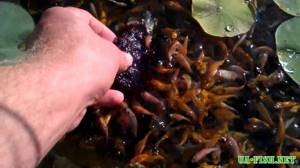
Sometimes, before going to spawn, several carp scout the area and when they find an ideal place for spawning, literally the next day a large school of carp appears there. They especially love flooded fields, where they chase females between the grasses and sometimes there are so shallow that their dorsal fins are visible, which is not particularly typical for carp. The spawning process itself takes place early in the morning and continues until 11 o’clock. Small moloshniks (2-3, sometimes 4) swim around one female on the sides. They push each other aside and release milk at such a high speed that even the squelching and whistling of the milkmen can be heard a kilometer away. It is known that when carp go in search of an ideal place for spawning, they can overcome large obstacles up to 2 m high, while pond carp are less whimsical and, like crucian carp, freely spawn on reeds and other plants. The carp has a huge amount of eggs and can easily be called a “heroine mother”, from 342,000 to 621,000 eggs, depending on the size and weight of the female. The color of the eggs, like those of bream and ide, is light green. The total weight of caviar can be half the weight of the fish itself. At normal temperatures (18-20 degrees), the embryo emerges from the eggs in 7-10 days, and at lower temperatures it can take all of 20 days, but with a sharp drop in temperature (8 degrees), the embryo may die. But after “cleaning” the rows of fry with water bee-eaters, perches, herons, water birds and pigs, after draining the areas where the eggs were laid closer to autumn, no more than 10 of the hatched carp remain. That is, if the female gave 300,000 fertile eggs, then only 3,000 of them will hatch, and after a year there will be 300 of them left. In pond carp, there are fewer such threats, and even if there is no fishing, there are an order of magnitude more carp than river carp. Since the carp hatch in the summer, and in September and October they stop feeding and go into hibernation, they grow relatively little in the first year. Carp feeds in places rich in plant and animal food. Its diet contains mollusks, crustaceans, worms, and insect larvae. The fry, two weeks old, feed on mosquito larvae and then on benthic organisms that live in the mud. Carp feeds almost without interruption, as they are stomachless fish. It is called an “omnivorous aquatic,” and is equated to a pig due to its unpretentiousness in choosing food, rapid growth and fatness. Looks for wide and deep areas with weak currents or standing water, with a soft clay or moderately muddy bottom. It does not avoid the hard bottom, unless it is rocky. Loves warm water, prefers overgrown reservoirs. Stays deep. The carp's danger signal is a series of crackling sounds made by the leader who has detected an enemy. Carp is not alone; during its existence, entire species of carp have formed, and even subspecies, so-called hybrids, for example, a mixture of carp and crucian carp, also called carpars, which even in adulthood is much smaller than ordinary carp and in Russia is mistakenly called by local fishermen buffalo. The view of Buffalo will be written below. Hybrid of carp and crucian carp - KARPOKARAS
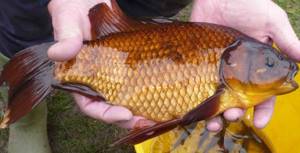
It is known that the main fish in the reservoirs of rural regions is crucian carp. As a result of the early sexual maturation of crucian carp and its high fertility, carp ponds quickly become clogged, causing intense food competition with cultivated fish species. However, it is characterized as a species resistant to unfavorable growing conditions, especially low oxygen content in water (up to 0.5 ml/l), while carp dies in such reservoirs. To introduce crucian carp into ichthyocomplexes, it becomes necessary to create a sterile (sterile) form of this species using a well-known method in fish farming - hybridization. When a male crucian carp is crossed with a female naked carp, scaly and linear offspring appear. Linear carp hybrids are very similar to linear carp. Research has established that in favorable conditions, in comparison with carp cultivation, crucian carp in the second year of life can have a mass of 400-500 g; in the third - 880-1500 g. This hybrid is an interesting object for use in non-drainage reservoirs with mortality phenomena - for sports and farm fishing. Caviar is obtained from six-year-old female carp, and milt is obtained from male crucian carp weighing more than 200 g using a pituitary injection. A double injection dose is used for male crucian carp, 1.5-2 mg/kg body weight. To fertilize 1 kg of carp caviar, use 5-7 ml of crucian carp milt. . The fertilization rate of eggs is almost 100%. For incubation, deglued, fertilized eggs are loaded into a 50-liter Weiss apparatus. The friendly hatching of carp carp larvae occurs on the third day of incubation at an average water temperature of 21.5˚. The yield of larvae is 96%. Juvenile carp carp at the larval stage cannot be distinguished from carp larvae. During control catches of nursery ponds, a clear division of hybrids into individuals with scales and those with few scales was observed. The appearance of scaly and small-scaled (linear) carp hybrids is the same as that of carp, but the absence of antennae is the first sign of carp. The growth rate of scaly carp is slightly higher than that of small-scaled carp. Histological studies of the development of the reproductive system of carp carp confirmed their sterility. Breeding carp hybrids, which have an attractive presentation, makes it possible to increase fish productivity to an additional 9 c/ha. Hybrids of carp crucian carp have economic prospects: their omnivorous nature and high resistance to death phenomena in water bodies guarantee stable fish productivity. Karpokaras is an attractive object for sport fish farming. Koi carp 15 kg
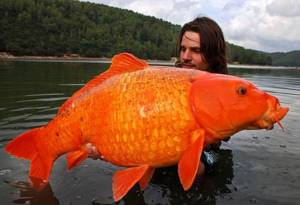
I will give the types of carp not only in the scientific classification, but also in the common folk classification (fishing, according to the place of birth). Types of carp by scaly cover: - Scaly carp - Mirror carp - Naked carp Types of carp by intended use: - Industrial. Natural colored carp. — Decarative. Koi colored carp. Types of carp by body shape: - Oblong. — Oval. -Round. Types of carp according to the place of residence of local fishermen from Belogrudy Island: - Carp. A domesticated form of wild carp, it lives in bodies of standing water. — Korop. A domesticated form of wild carp, it lives in bodies of water with currents. - Sazan. Indigenous, wild inhabitant of bodies of water with currents. Breeds of carp: Sarboyansky, Parsky, Ukrainian scaly, Ukrainian framed, Altai mirror, Ropshinsky. One-year-old carps weigh 25-30 grams and from spring to autumn their weight will reach 500 grams. In the south of Ukraine 30-35 grams, and by autumn 600 grams. Koi Carp
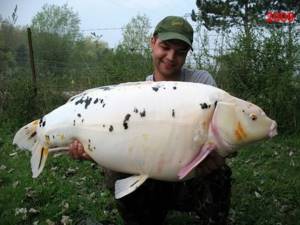
It is still not known exactly who was the first to breed carp for culinary purposes; some sources claim that it was the ancient Romans, others - the population of ancient China. Carp fishing Thanks to its impressive size and cunning, carp are a favorite trophy of many anglers. Carp fishing requires a lot of endurance and patience, sometimes you can wait for hours for a single bite, so carp fishing is not suitable for everyone. Carp is caught from early spring to late autumn; it is believed that the most successful time of year for fishing is late summer and early autumn. In carp fishing, both float and bottom gear are used. You can catch carp in winter, even from under the ice, but this fishing is no longer so productive. Carp fishing in winter
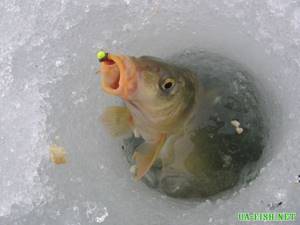
The bait used is: - Bloodworm (mosquito larva) - Worm (dung or earthworm) - Maggot (maggot in cinnamon is very popular) - Corn (canned, steamed, boiled or swollen) - Barley (steamed) - Peas (canned, steamed) - Peanuts (steamed) - Beans (canned, steamed) - Semolina (kneaded with water) - Dough (kneaded with water) - Bread (crumb or crust) - Boilies (dumplings, dumplings - industrial or homemade prepared by boiling, drying or baking pieces of dough with additives) - Potatoes (cooked tubers) - Jerusalem artichoke (cooked tubers) - Chufa (tiger nut, boiled tubers) Catching carp with boilies (dumplings)
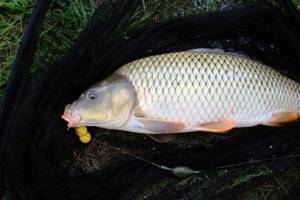
To improve the bite, it is recommended to feed the fishing spot; both ready-made mixtures and homemade ones are used as complementary food (they include cereal grains and cereals). It is recommended to add the intended bait to the complementary food, approximately 5-10% of the weight of the complementary food. Fixing the weight of record carp World records are traditionally fixed by the place of residence of the caught carp, rather than by the “registration” of the fisherman, whereas in the case of national records, the fish and the fisherman must be “fellow citizens” of the same country. Generally speaking, the very procedure for registering carp records was not officially regulated by anyone for many years, since the global carp community, which now numbers, according to some estimates, over a million people, did not bother to create some kind of global organization that, among others, would resolve such issues. The embryo of such a structure was the recently formed International Carp Fishing Association (ICFA), which included eminent representatives of 19 European countries, as well as Israel, Canada and the USA. Ukraine is represented in it by the famous carp fishing master and organizer Gennady Medvedev. According to ICFA recommendations, an applicant for a record in the event of catching a large carp must complete the following formalities: - carefully determine the weight of the fish - take at least two photographs showing the trophy from both sides - accurately indicate the date of capture and the reservoir - obtain a certificate from at least one other person who was present When weighing the fish and subsequently returning it to its native element, send your report and eyewitness testimony to the ICFA representative. ICFA “jurors” will review the documents received, check the accuracy of the information and, if the decision is positive, issue a personal certificate to the fisherman. It is clear that the trophy should be taken sportingly: with a fishing rod with one hook. The American Carp Society went even further, declaring that records in the United States would only be set for carp caught with a hair hook. By the way, in this country, for carp anglers, a prize of tens and even hundreds of thousands of dollars is often set for a record fish! Let's hope that over time the Ukrainian national carp record, which officially stands at a modest 23,850 kg (2007), will reach the European level. Record carp Where caught Who caught Weight Germany Dieter-Marcus Stein (Germany) 38.15 kg
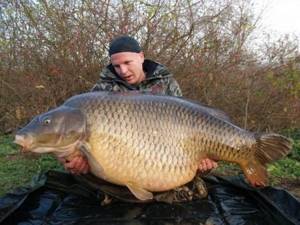
Germany Nermin Caro 39.60 kg France Graham Slaughter (Germany) 40.09 kg
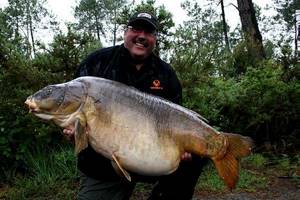
England Andre Komornicki 41.28 kg
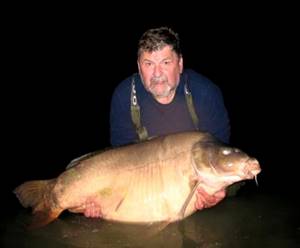
France Martin Lock (England) 42.63 kg
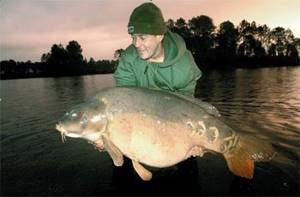
France Ambrose Smith and John Bryan (England) 44.9 kg
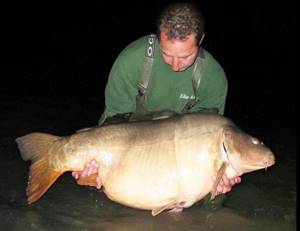
Hungary Roman Hanke 45.5 kg,
Similar articles:
News from reservoirs → Stavok between the village. Shchaslivka and Marinovka, Domanevsky district
News from reservoirs → ..Nature has no bad weather...
News from reservoirs → At the quarry headquarters near the village. Mostovoe Bratsk district is home to large carp
ways and methods of carp fishing → Carp fishing in the Nikolaev region
News from the reservoirs → Betting in the Krivoozersky region - a Klondike for carpomaniacs (VIDEO)
When copying material to other resources, the link is https://carpoman.com Carp fishing in Ukraine is a must! — 3305813
